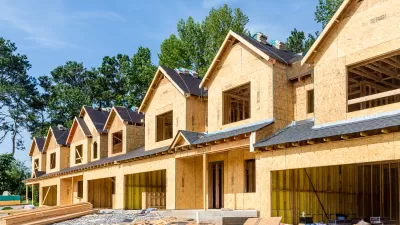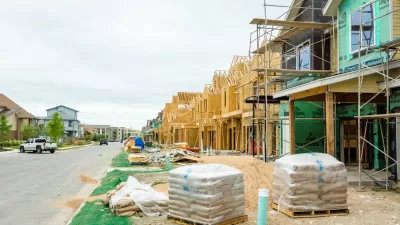Australia's housing market has built steadily at market rates but housing affordability has remained steady. What if building waves of new supply isn't enough to improve affordable housing options for those in need?

An article with a small committee of writers, and published by The Conversation, aims to debunk policy clichés "that keep reemerging" in the face of Australia's affordable housing shortage.
To put it simply, this article is taking aim at supply side approaches to housing policy—i.e., loosening zoning to allow for more building. In Australia, according to this article, supply is booming, but that hasn't helped lower housing costs.
Australia’s new housing supply per capita is actually very strong by international standards. Over the past decade, supply of new units and apartments has been flowing in job-rich metropolitan areas with dense populations, which are also higher-value locations.
According to the cliché, this supply response should have cooled prices. Yet dwelling price inflation has surged even in metropolitan areas where new housing supply has exceeded population growth.
The article also takes aim at the notion of filtering, "whereby older housing moves down to the affordable end of the market over time." The authors claim that the evidence for filtering is thin in the United States. As for in Australia: "in Australia there’s still no evidence to suggest new housing supply has filtered across the housing stock to expand affordable housing opportunities for low-income Australians, or that it will do so any time soon."
The authors also argue that builders would stop building as soon as prices did cool, so "high levels of supply output are rarely sustained." All of these arguments lead to the conclusion that planning reform is inadequate as affordable housing strategy. The only solution, according to the article, is a larger affordable housing sector.
FULL STORY: Affordable housing policy failure still being fuelled by flawed analysis

Planetizen Federal Action Tracker
A weekly monitor of how Trump’s orders and actions are impacting planners and planning in America.

Restaurant Patios Were a Pandemic Win — Why Were They so Hard to Keep?
Social distancing requirements and changes in travel patterns prompted cities to pilot new uses for street and sidewalk space. Then it got complicated.

Map: Where Senate Republicans Want to Sell Your Public Lands
For public land advocates, the Senate Republicans’ proposal to sell millions of acres of public land in the West is “the biggest fight of their careers.”

Maui's Vacation Rental Debate Turns Ugly
Verbal attacks, misinformation campaigns and fistfights plague a high-stakes debate to convert thousands of vacation rentals into long-term housing.

San Francisco Suspends Traffic Calming Amidst Record Deaths
Citing “a challenging fiscal landscape,” the city will cease the program on the heels of 42 traffic deaths, including 24 pedestrians.

California Homeless Arrests, Citations Spike After Ruling
An investigation reveals that anti-homeless actions increased up to 500% after Grants Pass v. Johnson — even in cities claiming no policy change.
Urban Design for Planners 1: Software Tools
This six-course series explores essential urban design concepts using open source software and equips planners with the tools they need to participate fully in the urban design process.
Planning for Universal Design
Learn the tools for implementing Universal Design in planning regulations.
Heyer Gruel & Associates PA
JM Goldson LLC
Custer County Colorado
City of Camden Redevelopment Agency
City of Astoria
Transportation Research & Education Center (TREC) at Portland State University
Camden Redevelopment Agency
City of Claremont
Municipality of Princeton (NJ)





























